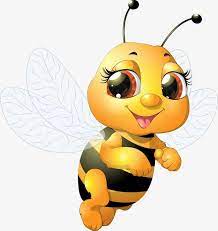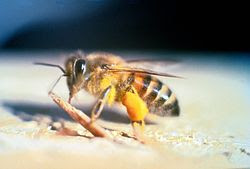Let’s Change the Subject and Talk About… Killer Bees
Sunday afternoons, various members of the Ford and Fitzgerald clans gather at the Swamp House (K’s term for our cottage at Paradise Palms) for coffee and conversation. We do our best to avoid politics because… well, I don’t have to explain how that can go these days.
The usual topics range from updates on siblings and cousins to books and movies, sports, and what’s new in the gardens. What was new in the gardens this week was Uncle R’s campaign against a recent influx of bees.
Apparently, the two owl houses R and I had put high up in a copse of melaleuca trees several years ago had been taken over by the bees when, for whatever reason, the owls decided to relocate. There were, according to R, thousands of them. But they are not sweet little honeybees.

They are a dangerously aggressive species called Africanized honeybees – or, as some prefer to refer to them, “killer bees.”

Africanized Honeybee (Apis mellifera scutellata)
Killer bees! Finally, the whole family had something we could fear together! A threat that was frightening to all of us equally, regardless of what we thought of Trump or Biden or DeSantis!
And, oh, what a marvelous conversation it was, all of us united against a common enemy!
Here’s a sampling of some of what I learned from that conversation (most of it from R), fact-checked on Wikipedia for your edification:
* The killer bee is a hybrid species. It is the result of a 1956 effort in Brazil to mate bees from southern Africa with Brazilian bees to increase honey production.
* Apparently (and this is documented, although it sounds like the plot of a bad movie), a handful of those hybrid bees escaped quarantine, then quickly spread throughout Central and South America and then to Mexico and the US.
* Killer bees are meaner than “regular” bees. Much meaner. Melittologists (scientists specializing in the study of bees) don’t like using terms like “mean.” They point out that all the little fellers are doing is protecting their turf. So they prefer to describe them as “highly defensive.”
R explained what that means in practice. He told us that when he had an exterminator take down their nest, a band of several hundred escaped. Somehow aware that he was behind the attack on their headquarters, they set up an encampment in the eaves of a nearby barn and proceeded to launch vicious attacks against him whenever he came within twenty yards of their bivouac.
Sounds farfetched. And, indeed, R, an Irishman like yours truly, is not entirely loath to dressing up a story now and then. But when I fact-checked him, I discovered that it was probably true. Killer bees have even been known to chase people they consider to be their enemies for more than a quarter of a mile. And according to one source, they have killed “more than 1,000 humans and an unknown number of horses and other animals over the years.”
If you want to enjoy a surprisingly good movie about killer bees, I can recommend The Swarm (French, with subtitles).
Watch the trailer here.
 MarkFord
MarkFord